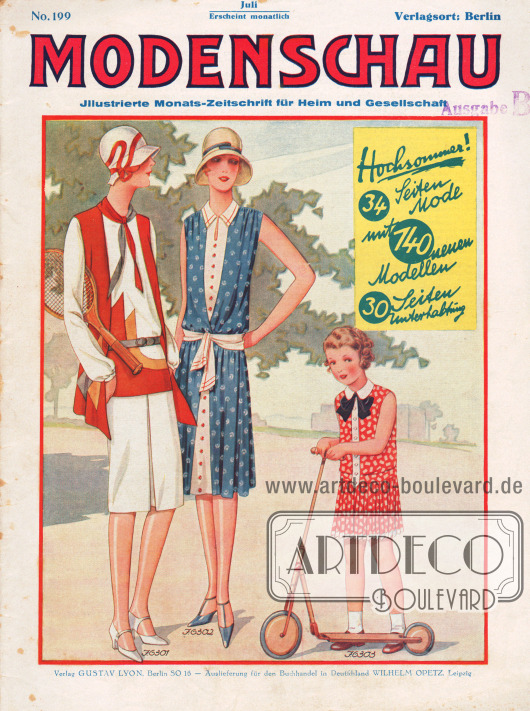|
|

|
Title page or front cover of the German fashion magazine Modenschau (Eng. title: Fashion Show, subtitle: Illustrated Monthly Magazine for Home and Society) no. 199 for July 1929.
Midsummer!
(34) pages of fashion with (140) new models. (30) pages of entertainment.
J 6301. Sporty suit in a combination of white and red wash silk fabric. Yellow and gray material as trimming. Fabric usage: 3.40 m white, 2.10 m red, each 80 cm wide. Pattern size 44 and 46. Price 1 mark.
J 6302. Dress for the hottest summer days made of blue and white foulard, trimmed with white material. Fabric usage: 2.50 m patterned, 0.75 m plain, each 100 cm wide. Pattern size 40 and 44. Price 1 mark.
J 6303. Dress made of patterned wool muslin for girls aged 4—8. White trim. Fabric size: 1.80 m 80 cm wide. Pattern 75 pf.
[Stamp:] Issue B [probably issue for subscribers].
July. Published monthly.
Place of publication: Berlin.
Publishing house Gustav Lyon, Berlin SO 16 — Distribution for the book trade in Germany Wilhelm Opetz, Leipzig.
Title illustration/title drawing: unknown/unsigned.
|
|
|
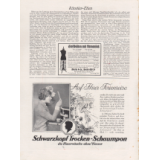
|
Article:
N. N., Artists' Marriages.
[N. N., Artists' Marriages.]
It is not only the performance of an actor on stage or in the movies that can interest the general public, but also his private life has always been the subject of keen observation. The spectator is all too happy to believe that it must be very easy for the artist to slip from the dream life of the stage into real life, while conversely the bourgeois man could not succeed in conjuring himself out of daily existence into the intoxication of theater life. Anyone who was an ideal lover on the stage as Karl-Heinz or Romeo should also have been one in life. Audiences have always been amazed — and still are today — when they learn that artists are also subject to life's inhibitions — perhaps even more so. Alphonse Daudet, who was as widely read an age ago as Edgar Wallace is today, raised the question: "Should artists marry", and answered it in the negative. This skepticism is not justified, however, because there have been many happy marriages among artists, even if there have of course been tragedies. But we must not forget that sensitive people, sensitive to the point of nervousness, are more likely than slow contemporaries to be worn down by obstacles and incidents that are inextricably linked to living together.
Perhaps things were different in the past than they have been in recent years, which have once again brought about a divorce between artistry and the bourgeois world. If we look at artistic marriages in the last decades of the last century, it is noticeable that a large percentage of them sought a partner from completely different social circles. In many cases, male and female stars of the stage and opera had spouses who came from a much higher social class than themselves. Even a circus performer once had no difficulty in finding a husband from the aristocracy, and both actors and singers were often able to marry women from aristocratic families.
In most cases, these marriages were harmonious. That a certain percentage did not turn out as desired was inevitable; for not in all cases did suitable temperaments clash, and so disappointment was bound to set in after a short period of understanding, as soon as everyday life claimed its rightful place in the marriage. This tendency to seek a spouse outside one's own sphere, the world of the theater, did not always lead to the circles of the aristocracy, however, but also to those of the propertied bourgeoisie, to the world of scholars or inventors. The great female tragedians of the German stage were all married to men whose profession had nothing to do with artistry.
It would now be reasonable to assume that in recent times, when the external barriers between the individual classes have fallen, there could be talk of a further expansion of this desire for marriage between artists and citizens. For the numerous inhibitions which formerly made it difficult and sometimes even impossible for these unions to come about have now almost completely disappeared. However, we can see that exactly the opposite has happened. It should not be denied that in recent years a few female stage artists have entered the circle of the aristocracy through marriage, and a few have married men from great bourgeois houses, but in general this development can be regarded as complete — both here and to an even greater extent in America. … (For the conclusion see second inside cover page).
Advertising:
Tailor's dummies with arm attachment. Fig. 42 slim. " 44 medium. Fig. 46 strong. " 48 very strong.
Great, great, long-waisted dummies for costumes and ready-to-wear. Length of the dummies alone approx. 70 cm. Very neatly executed, covered with good, durable cotton fabric, in all sizes (without stand) including postage and packing… RM 11.—.
do. do. with elegant extra tripod stand including postage and packing… RM 16.—.
do. do. with elegant tripod stand and good adjustable skirt including postage and packing… RM 23.—.
ADJUSTABLE AND MEN'S TAILOR DUMMIES.
Skirt maker highly practical… RM 8.—.
Merlitz & Co, Berlin SW 29, Willibald-Alexis-Strasse 40. Postal check: Berlin 13521, catalog free.
On your vacation trip you will be judged more than usual by your appearance. So make sure you have a smart hairstyle! If you don't have the time or opportunity to wash your hair thoroughly, think of Schwarzkopf-Trocken-Schaumpon [dry shampoo]! In 3 minutes you can have the most beautiful hair by simply powdering and brushing it out without destroying your marcel waves. But please note: only Schwarzkopf-Trocken-Schaumpon has the practical powder bag! The Mark 1 tin will last for months. Schwarzkopf-Trocken-Schaumpon for shampooing without water. [Photo: German] film actress Mary Kid [1904-1986]. Phot. Badekow. Photo: Martin Badekow (1892-1961). Drawing/illustration: "Doerfel" (unknown artist).
|
|
P. 1 |
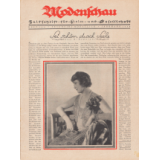
|
Title page or cover of the Modenschau (Eng. title: Fashion Show, subtitle: magazine for home and society) no. 199 for July 1929.
Article:
Rudolphi, Rose, Be Beautiful Through Soul (by Rose Rudolphi, unknown author).
At the center of the article is a large-format photograph of Kaethe Dorsch (1890-1957), sitting on a chair in a richly embroidered evening dress and long pearl necklace, her head half-turned away from the camera. The caption reads "Kaethe Dorsch, one of the most soulful German actresses. (Photo: Schneider)". Photo: Studio Ernst Schneider, Berlin (1881-1959).
[Rudolphi, Rose, Be Beautiful Through Soul.]
At all times, beauty was considered a gift that was only given to the chosen ones, but beauty was also a concept that was not always interpreted in the same way. In materialistic historical epochs, in which money played the leading role, beauty was inseparable from splendid finery, from dazzling pomp; and a Renaissance courtier noted the words characteristic of his age: "To have beautiful clothes is to be beautiful." If we examine the clothes of the Renaissance up to the end of the 19th century in this light, they turn out to be an end in themselves. They had the task of concealing flaws in the human body and pointing to artificial adornment, which of course could always be kept beautiful. The face was given the most advantageous possible appearance through appropriate hairstyles and the most complicated cosmetics were used to enhance it. Our time has rediscovered the body. The dress can no longer be used to conceal physical weaknesses as in the past, it no longer determines the line to be taken by the body by tying it up in whalebone and endless draperies of fabric, but its fit is determined by the body itself. The face can no longer be concealed behind an abundance of hair, for the fashion that demanded an abundance of hair that could not possibly be real is over, because every woman's natural hair is considered sufficient. In recent times, cosmetic methods have become extraordinarily refined, so that it is possible to correct disturbing flaws with their help. Applied at a young age, gymnastics can give the bone structure the necessary posture and elasticity from the outset. In addition, the methods of gymnastics combined with massage can also shape the adult body and correct some of the mistakes of a wrong lifestyle, even if they can no longer eliminate absolute disorders of the bone structure. Cosmetic surgery goes one step further. It can remove unsightly formations and, in particular, give the face an expression that comes close to general beauty. … (continued on page 8).
[Page] 1
|
|
P. 2 |
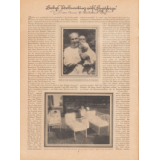
|
Article:
Wedekind, Anna P., Baby's Preparation for the "One Year Anniversary" (by Anna P. Wedekind or Anna Paula Wedekind-Pariselle, 1890-1979).
Two photographs are shown to accompany the text. The captions read "Professor Langstein, the head of the Reichsanstalt zur Bekaempfung der Saeuglings- und Kleinkinder-Sterblichkeit [Imperial Institute for Combating Infant and Toddler Mortality] with one of his fosterlings" (top) and "The little ones outdoors. — Light, air and sun are their best friends. — Photos: Wide World Photos."
Photos: US picture agency Wide World Photos (1919-1941).
[Wedekind, Anna P., Baby's Preparation for the "One Year Anniversary".]
Numbers are inexorable and incorruptible! Every year they announce a new decline in births in all parts of the fatherland. The economic hardship of the times finds eloquent expression here. As long as housing and other social hardships cannot be changed, it is unlikely that the curve of new citizens entering life will climb upwards again. All the more reason why every single little creature has become a treasure today, not only for the happy parents themselves: especially for the mother, for whom it means the fulfillment of the last, best womanhood, but also for the state, for the general public. We can be proud and glad that he is well aware of this responsibility and does everything on his own initiative to reduce infant mortality to an absolute minimum. At the turn of the century, statistics still had to indicate a mortality rate that is almost unthinkable by today's standards: for every 100 babies, 20 died before reaching the age of one. They had to die because their living conditions — especially the question of nutrition — were not sufficiently taken into account. Today, this figure has been reduced to a minimum! In Germany in particular, we have a model institute in the Reichsanstalt zur Bekaempfung der Saeuglings- und Kleinkinder-Sterblichkeit [Imperial Institute for Combating Infant and Toddler Mortality], the Kaiserin-Auguste-Viktoria-Haus [Empress Auguste Viktoria House], which — since 1911 under Professor Langstein's direction — can rightly call itself a "World School for Mother and Child"! This is where all the threads that combine science and social care come together to achieve the one great, mighty goal: to turn babies into healthy, viable human beings beyond the critical first year. One is amazed at the abundance of exemplary organizations — only the majority reflects the impression that a first visit to this cosmopolitan city offers! You have to agree with the guide who asks: "Didn't you imagine it to be quite different?" Yes, of course, we had cherished some vague idea of huge flocks of babies and had actually completely forgotten that we were supposed to get to know a research institute, a center of all infant and toddler care, of all science that encompasses the care and nutrition of children from the earliest age! It was from here that the threads first ran into the Reich, in order to make the results achieved by central offices, local authorities or associations available to the general public and thus to each individual mother. And from the Reich itself, from all these mostly independent organizations, all the individual material was returned to this giant center of infant protection to be evaluated here for scientific research down to the last detail. It was here that the idea of the mothers' advice centers, which today have such an infinitely beneficial effect everywhere in the Reich, first arose; it was here that the fight against the lack of understanding and the lack of hygiene, to which so many little human blossoms have fallen victim, began. It is still going on: prejudices and bad habits are too deeply rooted in the people to have been completely eradicated in the relatively short time that this youngest science has been in existence! But the maternity school courses, the instructive lectures that are held everywhere today to provide information, the traveling exhibition, the films recorded in the Kaiserin-Auguste-Viktoria-Haus itself, continue the fight incessantly and with ever-increasing success. The younger generation of mothers in particular takes their duties very seriously and tries with holy zeal to prepare themselves for the most beautiful task in a woman's life. The statistics of the Langstein House (as it is often called today after the name of its director) report a great rush to the mother school courses in all parts of the Reich. More and more young girls are registering for training as infant nurses — the state-approved infant nursing school is affiliated to the Reichsanstalt [Reich Institute]. … [continued on next page 3].
[Page] 2
|
|
P. 3 |
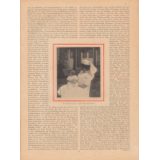
|
Article:
Wedekind, Anna P., Baby's Preparation for the "One Year Anniversary" (by Anna P. Wedekind or Anna Paula Wedekind-Pariselle, 1890-1979).
A photograph showing a seated nurse in the garden matches the text. A baby is sitting on her lap, its head turned away from her. The caption reads "Who's coming?" Photo: Wide World Photos.
Photo: US picture agency Wide World Photos (1919-1941).
[Wedekind, Anna P., Baby's Preparation for the "One Year Anniversary".]
[Continued from previous page 2] … How many of them hope to find a substitute for their own happiness through other people's children in this most feminine of all professions! Mustn't it be wonderful to dedicate your life to these smallest of the small, to be able to witness the awakening of the little psyche, this most inexplicable miracle of creation, day after day? When you see the contented, happy faces of the caregivers when they show you their little darlings, you know that many a lonely woman's heart has found purpose and fulfillment here! It is a high song of human love, not only of science, that rings through this city of houses outside Charlottenburg. You can't help but feel a glimmer of joy in your eyes as you are guided through the countless departments. First of all, there is the maternity hospital, which is of course equipped with every conceivable facility to give the mother giving birth the greatest possible protection so that her baby is born healthy! For the child itself, however, care is now provided that combines science, care and love in order to bring the child safely through this most vulnerable time of its life. Success is proven, proven by the deliberate, incorruptible figures of statistics. How is it achieved? First and foremost, through the cleanest care and natural nutrition. "A mother's milk and heart are irreplaceable!" This motto of the house says enough! Hardly ever does a baby die from a nutritional disorder if it is fed with women's milk, the kind guide assures me. "The mother should try to do it for at least the first three months. — You wouldn't believe how important that is for mother and child!" I readily believe it, but nevertheless my objection was not unjustified that many mothers today are often unable to feed their children for professional reasons, which also have to be fulfilled. "Then the doctor must be consulted! He determines the composition of the artificial food! If there is no money to go to the pediatrician, the welfare offices, which are now under the supervision of specialists in all cities, will be happy to advise and help! Only a sense of responsibility must guide the young mother — then her child will and must stay healthy!" We go on to talk about infant formula — a makeshift, like any substitute! A huge research apparatus is dedicated to its composition here at the Reichsanstalt, tirelessly searching for new, even safer, even happier ways to reduce the mortality rate of bottle-fed infants to a minimum on the basis of the material submitted and practical trials. Surprisingly good results have been achieved with buttermilk, which is dried using a special process and can thus be administered in varying doses to the little one-year-old aspirant. The leading nurse proudly shows me the well-behaved and steeply rising weight gain curve, which announces baby's well-being, on one of those "report cards" that are emblazoned on each of the little beds and report on baby's achievements in all areas. It was a baby who no longer wanted to drink and immediately began to work diligently on his health again with the change in diet: he gained weight, digested healthily, in other words fulfilled all those duties that are infinitely important in the first years of life. Incidentally, every mother could easily draw up such a table, which would make it easier for her and the doctor to diagnose any disorders that may occur — which, as we know, can very quickly become disasters in infants. Weight gain on the one hand and digestion on the other speak volumes! But a healthy, proper diet alone is not enough! Light, air and sun are at least as important factors. But they must also be able to reach the child's body! On one of the first beautiful spring days of this year, I saw a very expensive blue baby carriage in Berlin's most elegant residential district, led by an extremely decorative-looking "nurse", which instead of the nice, friendly blanket had a tightly stretched white oilcloth which — listen and be amazed! — rose up to half the height of the raised canopy. Only a narrow gap remained at the top for the air, the spirit of life! Modern baby prison! Even a few older ladies, who usually don't approve of modern baby care methods, shook their heads in disbelief. They already knew so much about modern endeavors that this air barrier was certainly not healthy. Had the poor worm underneath also been packed into feather beds? Unfortunately, I couldn't find out. Poor, rich child! On the other hand, how good it is for those little ones who are allowed to spend their first year of life outside in the Kaiserin-Auguste-Viktoria-Haus: these little ones, most of whom entered life unwanted, are offered a doubly sheltered home out here. The affiliated maternity home also gives the mother the protection and support that is so important for both of them in the early days. The expectant mother must come to the home six weeks before the birth and stay there for at least three months afterwards: a beneficial measure to ensure the all-important natural nourishment for the child. But the mother can also stay there for a whole year in return for doing housework, can be given a proven position as a wet nurse, in short — she too is taken care of, always with the best interests of the baby in mind. When you consider how many such poor, illegitimate worms, who are themselves so blameless, used to lead a miserable existence with so-called foster mothers until their mostly happy end, then you realize the blessing of today's care, to which every single child is equally dear and worthy. How happily beaming, how healthy these little ones laugh into existence, who are immediately pushed outside at the first beautiful warm sunshine — onto the sunbathing terraces, into the delightful little garden, where the life of the older ones takes place. … (continued on page 15).
[Page] 3
|
|
P. 4 |
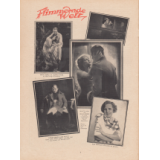
|
Flickering world. [Page with five photographs from movies.]
GRETA GARBO [1905-1990] and CONRAD NAGEL [1897-1970] in: "The Mysterious Lady".
BRIGITTE HELM [1908-1996] and FRANZ LEDERER [Francis Lederer, 1899-2000] in: "The Wonderful Lies of Nina Petrovna".
WERNER KRAUSS [1884-1959] in "Napoleon at Saint Helena".
Top right: LILIAN HARVEY [1906-1968] and IGO SYM [1896-1941] in "The Model from Montparnasse" or alternative title "Adieu Mascotte".
OSSI OSWALDA [1897-1947]: "Der Dieb im Schlafcoupé" ["The Thief in the Sleeping Coupe"] after the novel "Princess on Vacation".
Photos: M. G. M. Ufa Ostermayr.
Photos: M. G. M.; Ufa; Ostermayr (unknown photographer).
[Page] 4
|
|
P. 5 |
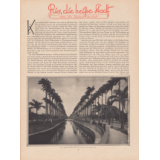
|
Article:
Hecht, Dr. Robert, Rio, the Hot City (by Dr. Robert Hecht, unknown author).
The lower half of the page shows a photograph with the caption "On the palm canal in Rio de Janeiro". Photo: unknown/unsigned.
[Hecht, Dr. Robert, Rio, the Hot City.]
No other city in America can compete in beauty with Rio de Janeiro, which is a shining tropical jewel. Rio is one of the hottest cities in the world, perhaps not suitable for permanent residence for a representative of the Nordic race who, for all his longing for the sun, needs the winter; but in its unity Rio is the best that human activity has wrested from the South American jungle. For one of the peculiarities of Brazil's capital is that the garden culture of its villa districts is not transformed into plantation farming in order to push back the jungle for many miles: but that the belt of jungle closes just behind the last suburban settlement — and an hour's drive from the harbor, giant snakes and jaguars lurk in the thicket, while crocodiles in the swamps not far away mock all campaigns of destruction.
Situated on a bay, Rio de Janeiro is a seaside city unlike any other in terms of attraction and beauty of design. The mirror-smooth Avenidas run along the beach for many kilometers, are protected from the sea by a high quay wall and offer the 12,000 cars enough space to let off steam. It is in the character of the Brazilians that they, who otherwise have no preference for speed, cannot get the speed of the cars fast enough. That's why, especially at night, when the streets are unbelievably humid before the coming thunderstorms, speedy drives along the sea are popular, especially as the well-maintained roads far outside the city are a temptation. On one side the sea rolls and gurgles, on the other the jungle rustles and haunts in strange tones. When the chauffeur switches on the car's headlights, the avenue comes alive with thousands of large sea crabs, which move from the water into the forest to catch unknown prey, and which now raise their claws in fright to attack the light like an enemy. This is Rio de Janeiro.
Of course, a cosmopolitan city cannot live on the idyllic alone, especially not a maritime city that is an important transshipment port and attracts ships from all over the world. Even this tropical place has not been able to shut itself off from the modern economic concentration efforts of world trade, which are leading to the formation of cities everywhere. But the southern preference for the ostentatious exterior has not been neglected here either. The business district, the world of offices, is not as unspeakably sober as in North America and Europe. The ground is just as resistant to the skyscraper type as the sense of the people, whose established class has the blood of Portuguese descendants and who are still culturally committed to the mother country and the larger Spain, even if their political convictions are of a completely different, Brazilian nature. That is why the city of Rio de Janeiro is a neighborhood that offers a lively view, and where work itself is still putting on a pretty robe. … (end on page 10).
[Page] 5
|
|
P. 6 |
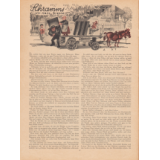
|
Article:
Brennert, Hans, The Schramms (by Hans Brennert or Johannes Adolf Otto Brennert, 1870-1942).
The drawing above shows a delivery of coal with a horse and cart for a middle-class housing estate. The coal carrier is piggybacking the stacked coal briquettes while a plump woman helps him. A woman leans against a pillar of the fence and observes the scene. A dog sits on the coachman's seat. In the background is a house surrounded by trees and an iron fence. On the underside of the truck is a sign with the inscription "Carl Schramm, Kohlenhandlung [coal merchant], Berlin-Lichterfelde, Kastanienallee 27". Drawing/illustration: Hans Ewald Kossatz (1901-1985).
[Page] 6
|
|
P. 7 |
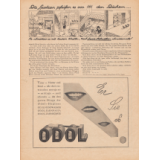
|
Article:
Brennert, Hans, The Schramms (by Hans Brennert or Johannes Adolf Otto Brennert, 1870-1942).
At the top is a drawn short story that is intended as an advertisement for dresses made according to Lyon patterns. The description reads "The sparrows whistle it from the rooftops… They blare it with a loud peal: 'Everyone is tailoring to the Lyon pattern'". Drawing/illustration: Hans Ewald Kossatz (1901-1985).
Advertisement:
He… She… It… Father — mother and child — all three use morning — noon — and night — the three good things of Odol hygiene. ODOL MOUTHWASH. ODOL TOOTHPASTE. ODOL TOOTHBRUSH. Drawing/illustration: unknown/unsigned.
[Page] 7
|
|
P. 8 |

|
Article:
Rudolphi, Rose, Be Beautiful Through Soul (by Rose Rudolphi, unknown author).
[Rudolphi, Rose, Be Beautiful Through Soul.]
(Continued [from page 1]) … But even the most artistic chiroplasty is only an afterthought. A face that does not appear animated, i.e. is internally fueled, is not considered beautiful. Boring, pale beauties have long since gone out of fashion.
So what do we actually find beautiful in a person? A healthy, normal physique is a prerequisite for aesthetic consideration, but it alone is not enough to attract attention. There are enough people whose stature is not the least bit objectionable and yet no one would describe them as beautiful. For although beauty depends on the design of the body as a whole, and is even supported by secondary things such as gait, posture, gestures, even voice and manner of speaking, it is always the face that determines the extent to which a person can be considered beautiful. But there are certainly several kinds of beauty. In most cases, regularity is necessary for its expression. Strangely enough, the two halves of the body are not equal, so that each person also has two different halves of the face. The smaller these deviations are, the more regular a face is, the closer it is to the Greek type of beauty, which is still considered exemplary. However, today we have freed ourselves from the absolute tyranny of the ideal of beauty of antiquity. Today, the strict regularity of Greek images is perceived by art as what it once was, namely as a stylization of absolute beauty. This ideal, however, does not correspond to the truth, and that is why faces that come close to the Greek pictorial type are regarded today as expressionless and boring. Today we demand more from a face, we demand a speaking face, behind which we see a whole person who does not go through life in a somewhat chilly and aesthetic way, but with inner compassion.
Now it would be wrong, according to a misunderstood statement by Nietzsche, to demand faces that are as individual as possible. As much as we today find dolls' heads ridiculous, even unbearable, an unrestrained individualism will not lead to beauty. How is it that there are so few ugly children, indeed that at a certain age all young creatures can be described as cute? There is purity and truth in children, which life often destroys afterwards. Whoever can preserve the childlike type of impartiality for a long time will also be able to preserve beauty for a long time. It is no coincidence, but the natural connection between mother and child, that women can preserve the childlike type until old age. The man moves away from this in the years of puberty — that's why there are so many ageing women who still show traces of beauty, while men of the same age have become graying ugly. The child is pretty because it has no worries yet and only thinks about the immediate things. For it is indisputable that thoughts determine the expression of the features and that the inner life shapes the plastic appearance of the face. We are talking about thinking foreheads, which rise up powerfully and determine the appearance of the face. A few years ago, it seemed as if a few women who had turned to science wanted to make the thinker's forehead popular with the female sex as well. But this bad habit soon passed, and it was recognized that a woman's emotional inclinations must prohibit her from masculinizing herself.
There is no need to consider everything that comes from America to be excellent, and we will certainly not advocate a far-reaching Americanization. Nevertheless, the life admonition "keep smiling" — try it with a smile — is proving to be very beneficial. Everyone prefers to look at young, smiling faces rather than those that have been plowed up by the storms of life. The excessive seriousness with which we try to solve many questions of everyday life is pointless. Certainly, as soon as major tasks are involved, one should approach them with seriousness and conscientiousness and should not allow oneself to be put off spending the necessary time on them, … [continued on next page 9].
Advertising:
AEG VACUUM CLEANER VAMPYR. AVAILABLE EVERYWHERE — PRICE RM 130.—. PART PAYMENT RM 140.—.
A friend for life. The SINGER sewing machine. (SINGER SEWING MACHINES SINGER) Extensive payment facilities. Moderate monthly installments. SINGER NAEHMASCHINEN AKTIENGESELLSCHAFT [stock corporation]. Singer stores everywhere. Drawing/illustration: unknown/unsigned.
[Page] 8
|



